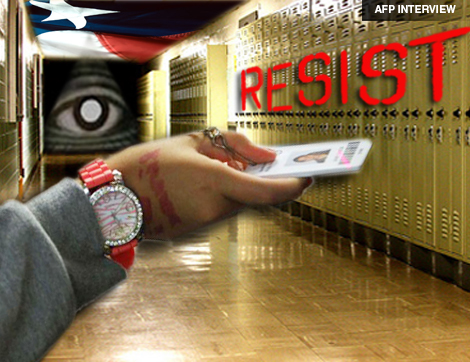
• Critics say mandatory use of trackable microchip IDs makes better ‘prisoners’—not better ‘students’
By Mark Anderson
SAN ANTONIO, Texas—The San Antonio sophomore who opposed microchipping student IDs that would track their every movement has inspired a groundswell of 300 students in her huge district who now refuse to wear the identification chips over religious, personal privacy, safety and civil liberties concerns. In addition, some 700 other people have signed petitions opposing the microchipping program.
VIDEO INTERVIEW: Students Rise Up Against Forced Chipping
AMERICAN FREE PRESS first reported this story in the September 17 & 24 edition. On November 12, Andrea Hernandez, and her determined father, Steven, met with this AFP writer to update their fight against the attempted requirement by the Northside Independent School District (NISD) for all 4,200 students in John Jay High School and Anson Jones Middle School to wear microchipped student-picture IDs, worn like necklaces.
Most of the students objecting to the chipped IDs are in the high school, yet at Anson Jones, some parents “are taking out their kids, because they said, ‘we don’t want to be part of this,’ and the media covers that up,” Mr. Hernandez told AFP.
NISD started its “Student Locator Project” in August. School documents show the total upfront implementation price for just those two buildings is $552,350. NISD wants to eventually force all 100,000 students in the sprawling district’s 112 school buildings to wear the chipped badges.
RFID (remote frequency identification) chips, according to NISD, enable school officials to track students on campus, monitor their whereabouts and confirm their attendance. In addition, the Hernandezes believe that NISD is mainly pushing the issue to achieve the attendance goals needed to qualify for about $2 million in state education aid.
Mr. Hernandez is awaiting a response from school administrators to a letter he delivered to them October 19 in which he refused their most recent proposed remedy of allowing Andrea to discreetly wear an ID that is not microchipped, as long as she outwardly supports the RFID program.
Mr. Hernandez related to AFP that he protested: “My daughter is not going to wear the symbol of your program so she can put a pretty face on [it].”
He recalled being told by one administrator: “She won’t have to wear the chip, but she’ll fall in line like everybody else,” hence Steven’s objections extend to the basic premise behind the program, not simply whether his daughter’s ID is chipped.
“It’d be a waste of time to wear an empty badge because I wouldn’t wear it anyway,” Miss Hernandez added, saying she would be content with wearing her basic freshman ID badge she received before the RFID issue arose.
Her father recalled the comment of a lady who, after learning about the RFID controversy during a recent school board meeting, may have summed it up best by telling the school board: “You are creating prisoners, not model citizens.”
In some instances students have destroyed their IDs. Others leave the IDs at home.
The program was supposed to be put before voters as a ballot proposal, but “they took it off the ballot and voted it [in] amongst themselves. . . . And the badges the faculty wear are fake—meaning no chip,” said Mr. Hernandez. RFID opponents see that as a double standard.
With the help of activists from We Are Change/San Antonio and We Are Change/Texas Hill Country, the Hernandezes collected the 700 petition signatures at football games and in other venues over the last few weeks to show officials there is broad opposition to tracking students like they are commodities—making school districts virtually indistinguishable from low-security prisons by establishing the basic components of captivity, which is made more overt by using RFID technology.
“That’s what they’ve reduced our children to—inventory,” said Mr. Hernandez, whose objections to the RFID program are based mainly on religious grounds.
In another new development, two new bills just filed in the state legislature in Austin, H.B. 101 and H.B. 102, would ban or control RFID student IDs statewide. “The first one . . . bans the use of RFID in any school district throughout the state of Texas,” Miss Hernandez told AFP. “The second one says it’s OK if your district has [RFID] but there has to be an opt-out program—and if there is an opt-out program, the people that go through that cannot have any negative consequences [brought] against them.”
Mr. Hernandez just secured the Virginia-based Rutherford Institute’s help. This helped him secure the services of Austin attorney Jerri Lynn Ward—a welcome development after he tried for weeks unsuccessfully to find an attorney who would listen.
Mr. Hernandez also said that, to try to contain the student rebellion, the NISD has stooped to picking out chip-wearing students at random to enter drawings for $5 gift cards. “And whatever high school class has the most kids wearing badges gets a pizza party,” he said.
“Do you want the program stopped school-wide?” AFP asked.
“We’re in [this battle] for the long haul. We want the program stopped. District-wide, statewide—we don’t want it at all,” he replied.
Mark Anderson is AFP’s roving editor. Listen to Mark’s weekly radio show and email him at [email protected].


1 Comment on Students Rise Up Against Forced Chipping